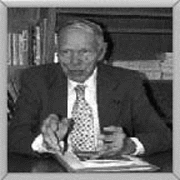 Glenn
Seaborg
was born in Ishpeming, Michigan in 1912. At the age of ten, his
family moved to California in pursuit of financial stability. In
1929, Seaborg graduated as Valedictorian of David Starr Jordan High
School in Watts. Seaborg attended UCLA, then obtained his Ph.D. at UC
Berkeley in 1937. Seaborg spent over sixty years at UC Berkeley, as a
student, a professor and even as Chancellor.
Glenn
Seaborg
was born in Ishpeming, Michigan in 1912. At the age of ten, his
family moved to California in pursuit of financial stability. In
1929, Seaborg graduated as Valedictorian of David Starr Jordan High
School in Watts. Seaborg attended UCLA, then obtained his Ph.D. at UC
Berkeley in 1937. Seaborg spent over sixty years at UC Berkeley, as a
student, a professor and even as Chancellor.
While at Berkeley, Seaborg identified over 100 radioisotopes, many of which are used to treat thyroid disease and cancer. In 1941, Seaborg synthesized and identified Plutonium, an element used in atomic bombs. In 1942 Seaborg was called to work on the Manhattan Project in The University of Chicago's Metallurgical Laboratory. There, scientists worked to produce enough fissionable plutonium to produce an atomic bomb. Although Seaborg believed it was imperative that that US develop the atomic bomb before the Nazi's, he was vehemently opposed to using the bomb on civilians. From 1954 to 1961 Seaborg served as director of Nuclear chemical research at Lawrence Radiation Laboratory. Then, in 1961 President Kennedy appointed Seaborg as head of the Atomic Energy Commission. In all, Seaborg advised 10 presidents and contributed to the Limited Nuclear Test Ban Treaty and the Non-Proliferation Treaty.
Seaborg dedicated the greatest portion of his career to his love of research. He discovered a total of 10 transuranium elements. Seaborg's greatest contribution to science was the "Actinide Concept" in which he boldly changed the location of Thorium, Protactinium and Uranium, along with the synthetic elements to a row of actinides just below the lanthanide series. This allowed for more accurate descriptions of the behavior and properties of these elements. This work earned Seaborg the 1951 Nobel Prize in Chemistry. In 1997 the element 106 was named Seaborgium in honor of Seaborg. This was the first and only element to be named after a man while he was still living.
Perhaps equal to his love of research, Seaborg was also deeply devoted to science education and reform. He served as a member of President Regan's National Commission on Excellence in Education which produced "A Nation at Risk, the Imperative for Educational Reform". He worked on the Chemical Education Material (CHEM) Study project which revolutionized the teaching of Chemistry. Seaborg also worked on the Great Explorations in Math and Science (GEMS) project which provides internet resoruces for science teachers. Most recently, Seaborg served as chairman of the Science Committee of the California Academic Standards Commission, working to set high standards for education in California. On February 25, 1999, Glenn Seaborg passed away in his home due to complications of a stroke he had suffered several months before.
Designed by: Cindi Krokower
Electronic Nobel Museum [Online]. Available at http://nobel.sdsc.edu/laureates/chemistry-1951-2.bio.html
Glenn Seaborg: His life and Contributions [Online]. Available at http://teidnt3.lbl.gov/seaborg